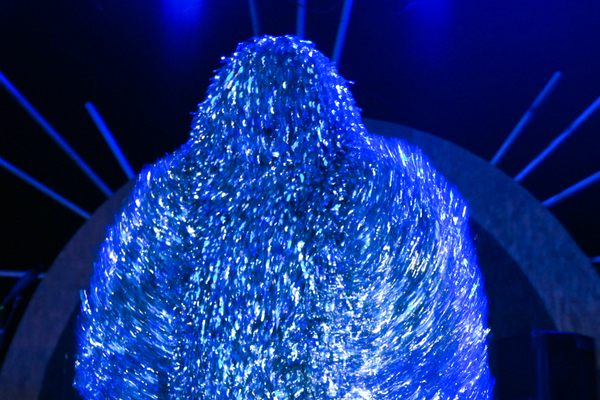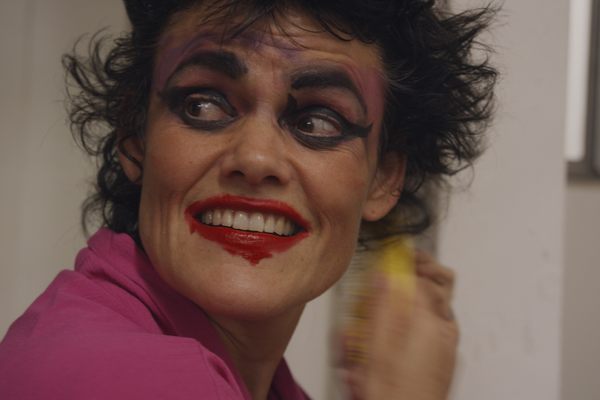How an 1892 ‘Trip to the Moon’ Changed How We Think About Space
New York theatergoers traversed the cosmos via Carnegie Hall.

Most days in 1892, ticketholders at Manhattan’s Carnegie Music Hall enjoyed programs of standard entertainment: the New York Philharmonic; a famous speaker; a ragtime show. But starting in February, every Monday, Wednesday, and Saturday, they got something a little different. As soon as the theater’s lights went down, the sun came up again, rising over an onstage lake that rippled just like the real thing. Next, the moon began to rise next to the sun, and gradually, dramatically obscured it. This was Scene #1 of A Trip to the Moon—a perfect rendition of the total solar eclipse of 1887, yanked through time and space and reconstructed inside the theater.
“Audiences had, in a sense, seen it all,” writes the media scholar Artemis Willis. But when curtain lifted on A Trip to the Moon’s first scene, “their cynicism yielded to wonder.” Over the next 90 minutes, viewers were treated to a number of rare and, at the time, impossible sights: lunar landscapes, cosmic nebulae, the earth as viewed from the moon, and more, all produced through an alchemy of stagecraft, lighting, and special effects. By the time they rose from their seats, Willis argues, they had absorbed not only facts and figures, but a whole new way of looking at space.
As Willis details in a recent paper about the show, A Trip to the Moon was first dreamed up in 1889, at the Urania Institute in Berlin. Unlike most observatories at the time, which had their hands full catering to experts, the Institute focused on curious laypeople—what one admirer, the astronomer Edward Holden, described as “that very large and intelligent section of the public which is intensely interested in the results of astronomical observation… but does not care at all for the small details which the special student must attend to.”

As part of these efforts, the Institute put together a number of stage presentations, which taught attendees about everything from the geological birth of Earth to the tides and currents of the Arctic Ocean. The shows proved extremely popular, and when word of them reached Andrew Carnegie, he decided to bring one or two over to New York City and stage them in his brand new Music Hall. “Mr. Carnegie’s idea is to discover whether there is real demand for such institutes in America, and to assist in founding them, if there is,” wrote Holden.
The Berlin version of the show was already a multimedia marvel, but for its own trip to the Music Hall—about seven times the size of the theater at the Urania Institute—A Trip to the Moon got even more gussied up. Larger versions of the set pieces were painted in Berlin and shipped over, and the staging took full advantage of the Music Hall’s recent renovations, during which the venue had been outfitted with electrical wiring and lighting.
Every scene involved what Willis calls an “electro-mechanical-theatrical tableau,” in which stage lights waxed, waned, and changed colors, magic lanterns projected scenes onto set pieces, and backstage crew members put various props through complex paces. Plus, it was all accurate: “Each move of the moon was charted to accurately reflect the phenomena, and then choreographed behind the scenes,” says Willis. “It would be really difficult to pull off such a performance today.”

For example, the climactic “Scene #6: Solar Eclipse as Seen from the Moon,” involved three celestial bodies, each differently positioned, and all interacting with one another. As illustrated at the top of this article, the moon—the scene’s vantage point—was represented by a painted canvas, lit from underneath by electric footlights. The sun was a lightbox sewn into a black drop cloth (which also had holes pricked in, for stars), and the earth was a phosphorescent disk with a ring of red gelatin around it. In the scene, the sun slowly crosses behind the earth, backlighting the gelatin and suffusing the stage with a red glow. The footlights below the canvas then gradually change to red, “transferring” the light of the eclipse to the moon’s surface.
A Trip to the Moon premiered on February 10, 1892, to an intrigued audience. But after a week and a half of lukewarm reviews, the production took the step that, in Willis’s view, really put it over the top: it went in for a script rewrite. The original narration, written by the Urania Institute’s Max Wilhelm Meyer and performed by a wide-eyed actor, “was sort of clunky and romantic,” Willis says. “The New York press picked up on that right away.”
As one New York Times critic wrote, the “Wagnerian drama” didn’t play well with this particular audience: “The lecture is heralded as gravely as if it were a new religion just discovered,” they wrote. “The audience is edified so gradually that there is more awe than comfort in it.”

The producers went out looking for a script doctor, and settled on Garrett P. Serviss, an astronomy columnist for the New York Sun. Over the course of nine days, Serviss rewrote the narration completely; when the show re-opened, he had taken on hosting duties as well. The result was a Trip to the Moon that, a happier Times critic wrote, was led “by someone who knew the way.” Where Meyer had spun grandiose tales, Serviss provided plainspoken explanations, grounded in facts. For example, during Scene #6, Serviss laid out exactly what was going on:
“Such an eclipse would present phenomena far different from those which we behold during a solar eclipse upon the earth. The most remarkable difference would be that arising from the fact that the earth is enveloped in air. The atmosphere of the earth, owing to its refractive property, acts like a lens surrounding the terrestrial globe, and bends the sunlight around its edge.
So, when the sun disappears behind the earth as seen from the moon, a brilliant circle of light girds the earth, and this light… produces a considerable illumination on the moon. The color of the luminous ring encircling the earth, under these circumstances, will be that of the sunrise and sunset sky, because the light has to penetrate the dust and vapor floating in the air, and the red rays most easily accomplish the passage.”
Compare this, Willis says, to Meyer’s version of the scene, in which the Earth is referred to as “the moon’s astral mother,” and its light as “the only agency of communication that is still left to her,” sent through space “a last greeting to her only daughter, lost so early in death.”

A hobbyist astronomer himself, Serviss also made sure to foreground the concerns of actual experts. “He would try to find ways to help his audiences imagine our relation to the cosmos as investigators of it,” says Willis. “[He was] encouraging a kind of mind travel, [as with the] ‘Spaceship of the Imagination’”—a device Carl Sagan used, in his seminal television show Cosmos, to represent the possibilities of scientific inquiry.
A Trip to the Moon played at the Music Hall for just over two years, and then did a short tour of the East Coast. Its creators went on to successful careers: Serviss began lecturing full-time (and later established himself as a prolific science fiction author), and the show’s lighting designer, J. Carl Mayrhofer, started his own company.

But in Willis’s reading, the show left another legacy: the ability for ordinary people to look at the heavens with something more than slack-jawed awe. Where earlier astronomical entertainments, including Meyer’s original A Trip to the Moon, leaned into astronomy’s reputation as “the sublime science”—full of proof of God’s limitless power, and humanity’s infinite smallness—A Trip to the Moon replaced some of that void-staring with curiosity. “It didn’t just say, ‘This is God’s great work, be afraid of it,’” says Willis. “It described the phenomena in terms that produced wonder.”
“The information was as new as possible, and the technology was as new as possible,” she says. “That’s where I think wonder was produced: in the space between the actual lunar phenomena, and the enactment of them.” As with an eclipse, in which the juxtaposition of the sun and the moon makes each more magnificent, A Trip to the Moon made knowledge and its representation dance around each other, equal at last.











Follow us on Twitter to get the latest on the world's hidden wonders.
Like us on Facebook to get the latest on the world's hidden wonders.
Follow us on Twitter Like us on Facebook